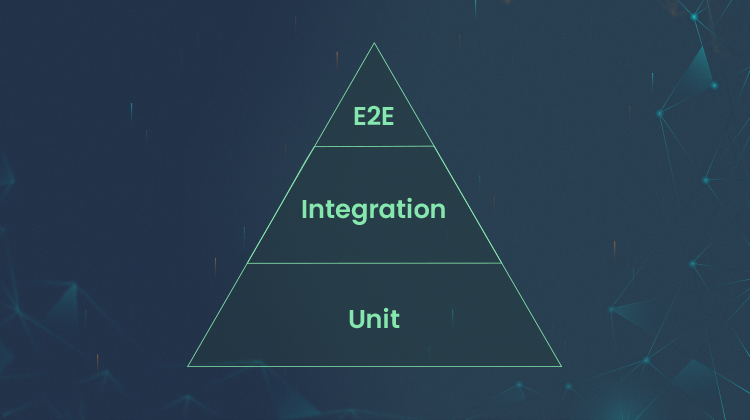Test Automation Pyramid: A Framework for SDET-Driven Testing

The test automation pyramid (often called the testing pyramid) is a visual model of the ideal test distribution in a software testing strategy.
It’s one of the tools in the Software Engineer in Test (SDET) collection.
By providing a framework for automated testing, the testing pyramid helps software development teams, SDETs, and quality assurance engineers improve software quality.
The strength of the test automation pyramid is that it offers immediate feedback on code changes, thus reducing developers’ time to identify if a change they made breaks the code.
It also helps the QA team build a more reliable test suite. Essentially, the testing pyramid details the type, sequence, and frequency of the tests that should be included in an automated test suite.
What is the Test Automation Pyramid?
The test automation pyramid is a visual representation of a testing strategy that prioritizes different types of automated tests based on their scope and execution speed. It’s shaped like a pyramid (naturally) with three levels.
1. Unit Tests
Unit tests form the base of the testing pyramid. These are the most fine-grained and fastest tests, focusing on individual units of code (functions, classes). Typically written by developers, unit tests run frequently throughout the development process and each time a new feature gets added. They are ideal for catching regressions and ensuring basic functionality is working correctly. They should make up the largest portion of automated tests.
2. Integration Tests
Integration tests focus on how smaller units of code interact with each other to form larger components or features. They are typically written by developers or testers and run less frequently than unit tests, but more frequently than end-to-end tests. Integration tests help ensure that different parts of the system are working together correctly. They also test interactions with external systems, such as databases and APIs.
3. End-to-End Tests
End-to-end (E2E) tests are the broadest and slowest tests, simulating real-user interactions with the entire system. They are typically written by testers and run the least frequently. E2E tests help ensure the overall user experience is smooth, and the system works as a whole. They are slow and hard to maintain; use them sparingly.
The pyramid shape emphasizes the idea that you should have more unit tests than integration tests, and more integration tests than E2E tests. This is because unit tests are faster to write and execute, and they can catch bugs earlier in the development process.
Benefits of the Test Automation Pyramid
There are many benefits to following the test automation pyramid.
Rapid feedback: Teams catch defects early, reducing overall testing time.
Improved quality: By catching bugs early and often, teams can improve the quality of the software.
Faster development: Automated tests can help developers find and fix bugs faster, speeding up the development process.
Reduced development costs: Fixing bugs early is cheaper than fixing them later in the development process.
Improved communication: The pyramid can help developers and testers communicate better about the different types of tests that are needed.
More reliable tests: Unit tests are less prone to breakage, leading to a more stable test suite.
Lower maintenance costs: Smaller and more focused tests are easier to maintain.
Better test coverage: The framework ensures testing at different levels, improving overall quality.
More efficient resource allocation: The testing pyramid prioritizes faster, more reliable tests.
Additional considerations:
How do SDETs use Test Automation Pyramids?
The test automation pyramid and the role of an SDET are closely intertwined. The pyramid provides a framework for effective test automation, while SDETs are the individuals who design, develop, and implement automated tests within that framework. Here’s how they connect.
Aligning Test Automation with the Pyramid
SDETs understand the test pyramid’s principles and apply them when choosing which types of tests to automate. They prioritize unit and integration tests due to their speed and efficiency, ensuring comprehensive coverage at the lower levels before moving on to more complex end-to-end tests.
Leveraging Automation Expertise
SDETs possess strong programming skills and are proficient in various test automation tools and frameworks. They leverage this expertise to create robust and maintainable automated tests across all levels of the pyramid.
Collaborating with Developers
SDETs work closely with developers throughout the software development lifecycle. They participate in code reviews, provide feedback on testability, and collaborate on building a unified testing strategy that adheres to the pyramid’s principles.
Driving Continuous Improvement
SDETs continuously analyze test results, identify gaps in coverage, and optimize the test suite. They strive to improve the efficiency and effectiveness of automated tests while ensuring adherence to the pyramid’s structure.
Contributing Beyond Automation
While automation is a core skill, SDETs also contribute beyond writing test scripts. They may be involved in manual testing, performance testing, security testing, and even participate in bug fixing based on their findings.
In essence, the test automation pyramid serves as a guide for SDETs to approach test automation strategically. By understanding and applying its principles, SDETs can contribute significantly to building high-quality software with efficient and effective testing practices.
The Importance of Test Automation
Test automation plays a crucial role in modern software development, bringing substantial benefits across various process stages.
Improved Software Quality
By automating repetitive tests, development and QA teams can run them frequently and catch regressions and bugs before they reach end users. This allows for quicker fixes and avoids costly post-release bug fixes.
Manual testing often has limitations in scope and time, leaving potential flaws undiscovered. Automation enables comprehensive testing with thousands of scenarios, improving overall software quality.
Automated tests follow pre-defined steps, eliminating human error and ensuring consistent execution and reliable results, fostering confidence in the software’s functionality.
Enhanced Development Efficiency
Automated tests provide immediate feedback on code changes, allowing developers to address issues quicker and iterate faster. This speeds up the development cycle and brings products to market sooner.
Time-consuming tasks like regression testing can be automated, freeing up testers for more exploratory and critical testing, allowing them to focus their expertise where it’s most valuable.
By automating basic checks, developers can focus on writing better code and implementing new features, boosting their overall productivity and contribution to the project.
Cost Optimization
Finding and fixing bugs early in the development cycle is significantly cheaper than fixing them later in production. Automation helps save costs associated with bug fixing, version rollbacks, and customer support issues.
Automating repetitive tasks allows testers to handle more complex tests and projects with the same resources, leading to better resource utilization and reduced overall testing costs.
Thoroughly tested and bug-free software leads to fewer post-release issues and support requests, reducing overall maintenance costs and potential damage to brand reputation.
Additional Benefits
Clear documentation and well-defined test scripts facilitate collaboration between developers and testers, promoting a better understanding of the system and its expected behavior.
Automated tests can easily be scaled to accommodate larger systems and complex functionalities, ensuring thorough testing even as the software grows in size and complexity.
Automated testing tools often provide detailed data and reports on test execution and results, offering valuable insights into software performance and potential areas for improvement.
While manual testing remains vital for certain aspects, incorporating test automation into your development strategy offers significant advantages in terms of software quality, efficiency, cost savings, and overall team performance.
Additional Considerations
The test automation pyramid provides a valuable framework for building a robust and efficient testing strategy.
By focusing on unit tests and carefully balancing different test types, teams can achieve faster feedback, reduce maintenance costs, and improve overall software quality.
Adapting the pyramid to specific project needs and regularly evaluating its effectiveness help ensure continuous testing success. The exact proportions of tests may vary depending on the project and its risks.
Regularly assess the pyramid’s effectiveness and make adjustments as needed.

